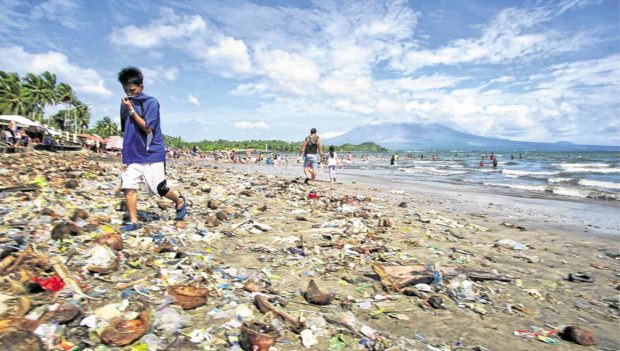
MAYON SPOILER The beach at Barangay Puro remains a popular destination for some families in Legazpi City despite the trash that spoils the view of Mayon volcano and the Albay Gulf. MARK ALVIC ESPLANA
LEGAZPI CITY — Below the “Legazpi” signage on the boulevard that offers a breathtaking view of Mayon volcano is a shoreline that remains dirty despite repeated community cleanup drives.
Residents believe that garbage strewn on the beach “traveled” from the adjacent town of Daraga through the Macabalo and Sagumayon rivers.
Resident Sipolito Biobo said stench from decaying animals on the beach was carried by “amihan” (cool northeast wind) to houses at Barangay Puro from September to December.
In summer, “habagat” (southwest monsoon wind) pushes waves to carry much of the trash further out to sea, residents said.
According to Nicasio Barrios, village chief of Puro, city government-funded cleanup drives every Saturday do little since garbage just keeps returning and spoils the beach.
“All that garbage either comes from residents living by the banks of Macabalo River, all the way from Daraga, or the open sea. Very little, if any, actually came from our residents because the city imposes strict policies on solid waste management and segregation,” he said.
Barrios said village chiefs in Legazpi and Daraga, including their mayors, were discussing ways to solve the recurring problem.
Reviving river
But Henry Jacob, municipal environment officer of Daraga, said trash reaching Puro beach could not be blamed solely on Daraga.
“Quarterly, the Department of Environment and Natural Resources (DENR) conducts cleanup drives in all ditches and drainage systems, streets, and the Sagumayon River (the river in Daraga linked to Legazpi’s Macabalo),” he said.
Some Daraga villages, he said, are conducting cleanup drives every Saturday while students from Bicol College and Daraga Community College regularly clean the river in Bagumbayan village.
The Daraga government has been working to clean, protect and revive the river, he said.
In the 1970s, Jacob said Sagumayon had clean water inhabited by little fish called “sagumayon,” from which the river got its name.
Information campaign
Sagumayon was so clean that residents would get their drinking water from wells along the river, he added.
But illegal settlers have slowly built makeshift structures along the banks and made the river their dump.
Jacob said information and education campaigns in riverside communities would help improve water quality and stop trash buildup on Puro beach.
“[But this] will take a number of years,” he said.
The establishment of a multisectoral river management committee, called “Bantay Ilog” (river guards), had been proposed.
“We are also hoping that the DENR … will come up with concrete plans to clean the river,” said Loreto Barajas, village chief of Sagpon in Daraga.
Legazpi City Mayor Noel Rosal said the Saturday cleanup drives were just short-term solutions, noting that the city government was strengthening its information, education and communication (IEC) campaign to clean the river and beach.
“But we have plans for a trap net. It is not easy, however, because we need equipment due to the large volume of trash,” he said.
Rosal said laws should be “strengthened” to arrest and penalize violators.
“It’s actually with the people. We might not even need nets if we are able to strengthen laws and IEC [campaign] as long-term solutions,” he said. —With a report from Maite Denis Bobis